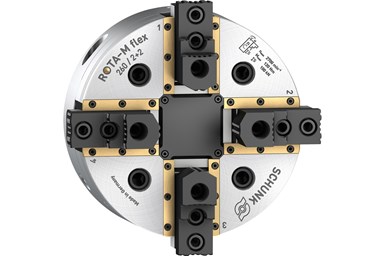Schunk Rota-M Flex 2+2 Maximizes Mill-Turn Flexibility
Schunk’s Rota-M flex 2+2 chuck jaw offers a level of flexibility that the company says is unmatched on the market and covers a wide range of part geometries.
Share





Schunk says it developed its Rota-M flex 2+2, a low-maintenance 2+2 chuck jaw, specifically for meeting the market’s increasing size and flexibility demands. The patent-pending compensating mechanism provides a compensation stroke that, depending on the model, amounts from 5.1 mm up to 10 mm per jaw — an amount Schunk says is more than provided by other available four-jaw chucks on the market. The company says this length increases flexibility for clampable workpiece geometries and opens up a wide variety of possible applications, while also saying that a single Rota-M flex 2+2 chuck will be sufficient for covering a wide range of part geometries.
According to Schunk, special seals on the guideways prevent grease from washing out under coolant pressure and gradual loss of clamping force. Even in case of low clamping forces, the company says the chuck will maintain precise functionality. At the same time, the sealings protect the chuck body against chips and dirt, increasing process safety and extending maintenance intervals. For increased safety, clamping on the Schunk Rota-M flex 2+2 operates in a self-locking manner, and indicating pins signal the clamping condition. The standard chuck sizes 260 to 1200 achieve jaw strokes from 9.5 mm to 17.8 mm and clamping forces from 100 kN to 180 kN.
As of size 800, users benefit from a weight-reduced design. The chuck face comes equipped with grooves, and fixed stops allow the chuck to double as a vise. Moreover, the large sizes are compatible with vertical lathes. The Schunk Rota-M flex 2+2 also includes a flexible serration (1.5 mm x 60° or 1/16” x 90°) to make the most of the chuck jaw’s size.
Related Content
-
Chuck Jaws Achieve 77% Weight Reduction Through 3D Printing
Alpha Precision Group (APG) has developed an innovative workholding design for faster spindle speeds through sinter-based additive manufacturing.
-
Medical Shop Performs Lights-Out Production in Five-Axes
Moving to five-axis machining enabled this shop to dramatically reduce setup time and increase lights-out capacity, but success relied on the right combination of workholding and automation.
-
Navigating Large-Scale CNC Machining: Suburban Tool’s Niche Strategy to Stay Competitive
Facing increasing competition from lower-cost imports, Suburban Tool made a move toward large-scale, in-house machining. By identifying a niche in large, precision angle plates and tombstones, the company has strengthened its ability to control quality and protect its reputation.






















